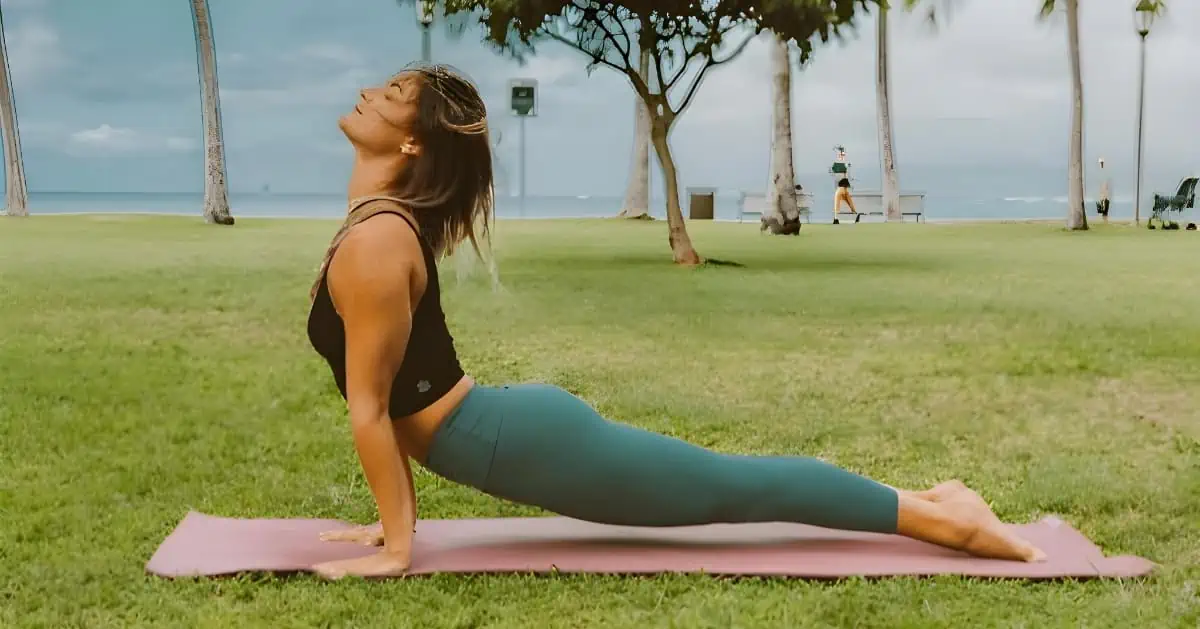Key Takeaway
Upward Facing Dog, a key pose in Sun Salutations, enhances spinal flexibility and strengthens the upper body when performed with proper alignment and awareness of common mistakes.
| UPWARD FACING DOG | |
|---|---|
| Alternate name: | Urdhva Mukha Svanasana |
| Difficulty level: | Beginner |
| Pose category: | Backbend |
| Muscle groups: | Pectoral muscles (chest) Deltoids (shoulders) Triceps (arms) Serratus anterior (ribs/shoulder blades) Rectus abdominis (abdomen) Obliques (abdomen/sides) Hip flexors (hips) Quadriceps (thighs) Erector spinae (spine) |
| Physical benefits: | Increases spinal flexibility, strengthens upper body, and encourages good posture. |
| Therapeutic applications: | Back pain, Posture improvement |
| Preparatory poses: | Cat-Cow Pose (Marjaryasana-Bitilasana) Cobra Pose (Bhujangasana) |
| Counterposes that follow well: | Child's Pose (Balasana) Downward Facing Dog (Adho Mukha Svanasana) |
| Chakras activated: | Heart Chakra (Anahata Chakra) |
| Most helpful prop: |  Yoga blocks under palms - reduces wrist pressure. See latest price |
Picture this: you’re flowing through your Sun Salutation, and there it is—the classic Upward Facing Dog Pose. It’s one of our yoga library’s most-used, often-practiced, and universally recognized poses.
But to be perfectly honest, it’s also one of the yoga poses I’ve seen executed with improper alignment. In beginning yoga students especially, one challenge is in realizing the difference between similar asanas like Cobra, Sphinx, and Seal Poses.
So, let’s break it down! In this blog, we will unpack the nuances of Upward Facing Dog, explore common mistakes, and discover how to finesse your way into that perfect heart-opening alignment.
By the time we’re done here, you can rest assured that when you flow into Upward Dog, you do it safely in a way that creates a harmonious balance between body, breath, and movement.
Grab your mats because we’re about to unravel the secrets of Upward Dog like never before!
Contents
- 1 Origins of a Classic Pose
- 2 Step-by-Step Guide Upward Dog
- 3 Common Errors in Upward Facing Dog Pose
- 4 Safety Tips and Contraindications
- 5 Modifications and Variations
- 6 Benefits of Practicing Upward Facing Dog Pose
- 7 Urdhva Mukha Anatomy Insights
- 8 Integrating Upward Facing Dog into Yoga Sequences
- 9 Preparatory and Follow-Up Poses for Balance
- 10 Conclusion
Origins of a Classic Pose
In modern yoga, Upward Facing Dog Pose is a fundamental posture in many yoga sequences. It’s a powerhouse of strength and flexibility, a heart-opener that beckons you to stretch, strengthen, and find that perfect balance between effort and ease.
Its Sanskrit name is a literal translation of its common English name:
- Urdhva: erect or upward
- Mukha: face
- Svana: dog
- Asana: pose
When giving cues during a yoga class, it’s common for us yoga teachers to abbreviate the asana name to “Urdhva Mukha,” “Upward Dog,” or even just “Up Dog.”
Though considered a classic pose, you might be surprised that Urdhva Mukha Svanasana didn’t appear until the 20th century as an alternative version to Cobra Pose. Upward Dog’s introduction was thanks to the “father of modern yoga,” T. Krishnamacharya, who adapted and popularized the Sun Salutation sequence.
Throughout the 20th century, his students Pattabhi Jois and B.K.S. Iyengar helped spread Vinyasa and Hatha yoga throughout the Western world. Those guys were real sticklers for alignment, so let’s get into the details of proper execution.
Step-by-Step Guide Upward Dog
Mastering Urdhva Mukha Svanasana involves a sequence of movements that awaken your back body, engage your core, and extend your spine. Executing each step with attention to form is crucial to prevent injury and maximize the benefits of this posture.
Setting Up
Since you’ll typically flow into this asana from another position, let’s begin with a standard transition that will help you set up your proper alignment:
- Start in Downward Facing Dog: Place your feet and hands at opposite ends of your mat, with your body in the shape of an upside-down “V.”
- Glide forward into a Plank position. Your feet should be separated no more than a hip-width distance, and your hands should be directly underneath your shoulders.
- Notice how your palms push the floor away, your core and shoulders are engaged, and your shoulder blades are spread wide across your upper back.
Making the Transition
- Untuck your toes so the tops of your feet press into your mat.
- Engage the muscles in your legs and core.
- As you inhale, press your hips forward, letting them sink toward the floor. Don’t lower all the way down — your shins, thighs, and hips should remain elevated.
- At the same time, pull your chest through your shoulders and reach the crown of your head forward and up.
- Maintain the engagement and placement of your shoulders and shoulder blades.
- Look straight ahead, keeping length in your neck.
- Hold for 3 to 5 breaths, stretching your spine and front body.
Moving out of this position requires strength — it’s a challenge, no matter how you go about it. Try both of these following options and discover which feels right for you.
Lower Down to Belly Savasana
Use your arm strength to lower yourself down to your mat gradually. Avoid letting your hips drop down first to avoid suddenly compressing your lumbar spine. As you bend your elbows, your thighs will reach the floor first, followed by your hips, abdomen, and upper body.
This method takes you through Cobra Pose and relies significantly on the arm muscles.
Return to Downward Dog
To return to your starting position, you’ll reverse the process used to enter the asana. The initial movement takes a lot of core power!
Use your abdominal muscles to lift your hips and return your body to a straight line, Plank position. Tuck your toes under one foot at a time. Then, again, use your core strength, arms, and shoulders to push back into Downward Facing Dog.
There are many ways to use this asana in yoga sequences, especially for creative yoga teachers. The suggestions provided here will help you master proper alignment. Then, once you’ve built up strength, you can explore pairing this asana with other yoga poses.
Common Errors in Upward Facing Dog Pose
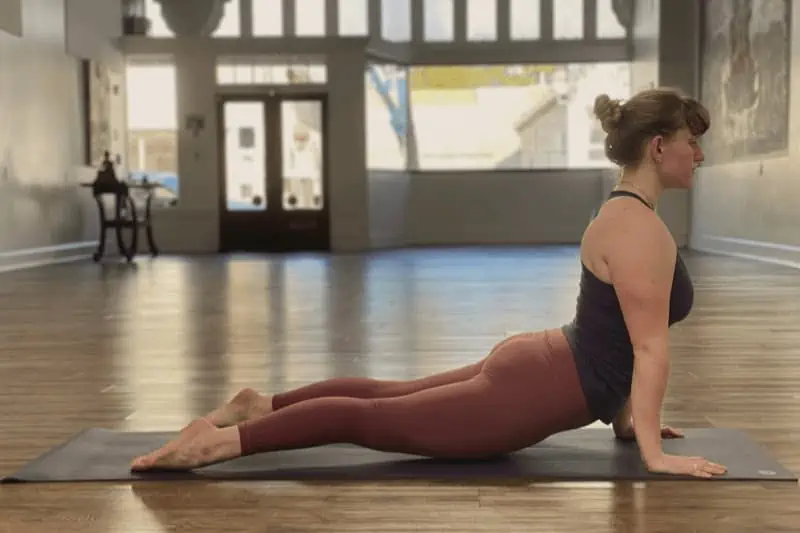
Urdhva Mukha Svanasana engages the whole body, so there’s a lot of anatomy to pay attention to! Plus, it’s easy to confuse this backbend with similar yoga poses; I’ve seen students mistakenly create a version of this asana resembling a combination of the Seal, Sphinx, and Cobra Poses.
Here are some of the most common Urdhva Mukha mistakes I see and how you can fix them.
Shoulder Positioning
A common tendency is to pinch the shoulder blades together, which causes the shoulders to shrug up around your ears. Instead, spread your shoulder blades wide across your upper back. Lift up and out of the shoulder joint, pushing the floor away.
Elbow Alignment
Hyperextending your joints can cause injuries over time. Maintain a micro-bend in the elbows to prevent this issue. A slight bend ensures that you’re engaging the muscles around the joint rather than relying solely on bone structure to hold you up.
No Lazy Legs
Keep those thighs lifted! Engaging the leg muscles prevents sagging hips, which can put unwanted pressure on your lower back. Imagine hovering your thighs just above the mat without touching it—that’s how much lift you want.
Neck Care
Another tendency I see is some students tilting their chin up and looking up toward the sky in this posture, which makes a kink in the neck. Instead, keep your gaze straight ahead: a neutral neck is better than compressing it by looking straight up at the ceiling.
Forcing the Backbend
Some students focus on shape more than sensation. Dropping your hips and thighs toward the floor might feel like you’re in a deeper backbend, but it creates compression due to the sharp angle in your lumbar area. Remember, this asana aims to create length in the back body. Focus on maintaining an even curve throughout your whole spine.
Safety Tips and Contraindications
Practicing yoga can be a source of great joy and health benefits. However, it is crucial to approach each pose with awareness, especially Upward Facing Dog Pose.
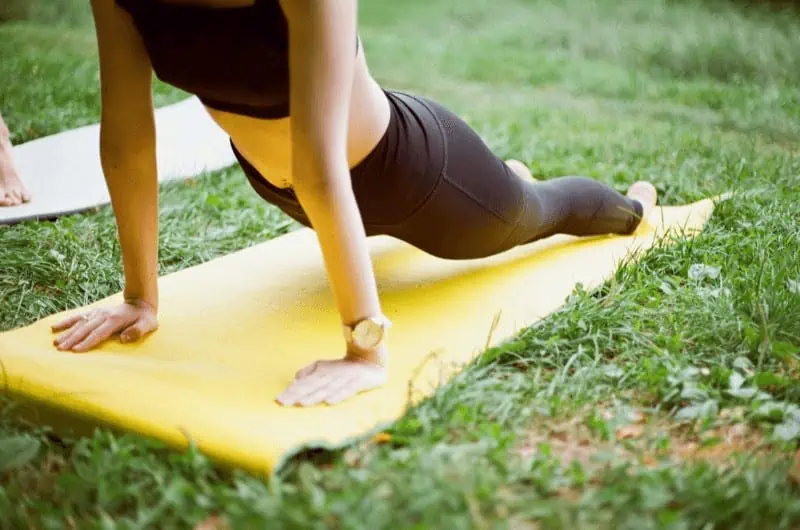
Sore Wrist Solutions
The hands bear weight in Urdhva Mukha Svanasana while the wrists are flexed. That position might be uncomfortable for some people.
- First, spread your fingers wide and grip your mat with your fingertips. That will take some pressure off the heels of your hands and wrist joints. Distribute your weight evenly across both palms.
- You can also place your hands slightly in front of your shoulders to decrease the flexion angle in the wrist joints.
If you still experience discomfort, try using a folded blanket or yoga blocks under your hands.
Low Back Care
Many people experience low back discomfort in this asana due to improper alignment or poor muscle engagement.
- Keep your core active, pressing your navel in and up.
- Squeeze your glutes and keep your thighs lifted.
Engaging the surrounding muscles will help you hold your weight, working against the gravity that pulls your pelvis toward the floor.
Contraindications for Upward Facing Dog Pose
This asana poses a challenge as only the hands and tops of the feet remain on the floor, bearing all of the weight. For that reason, people with wrist issues like carpal tunnel syndrome and those with shoulder injuries should avoid this asana or use a variation like Cobra.
Similarly, if you’ve had recent abdominal surgery or are pregnant, do not attempt any asana that stretches the front body until you speak with a medical professional.
Modifications and Variations
Upward Facing Dog Pose can feel challenging, but don’t let that stop you! You can easily modify the position or substitute as you flow through your yoga sequences.
Using Props for Support
While you work on alignment, props can be a huge help. Here are some ways to give yourself extra support in Urdhva Mukha Svananasa.
- Yoga blocks: Place blocks under your palms to lessen pressure on the wrists and help elevate the legs. Here is one from lululemon.

lululemon’s Lift and Length Yoga Block
- Bolster: Place a bolster horizontally under the hips, letting some of your weight rest there as your arms build strength. This modification also relieves pressure on the low back. Here is a bolster from Manduka.

Manduka Yoga Rectangle Bolster Pillow - Lightweight, Removable eQua Microfiber Cover, Easy Carry...
See latest priceWant to make sure your home studio is fully set up for any modification? Check out more of our recommendations for the best yoga props here!
Cobra as Substitute
Cobra Pose is a gentler alternative to Upward Dog. It’s ideal for beginners or those with lower back sensitivities. In Cobra, you keep your elbows bent and use your back muscles more than your arms to lift your chest off the ground. This variation reduces strain on the wrists, too.
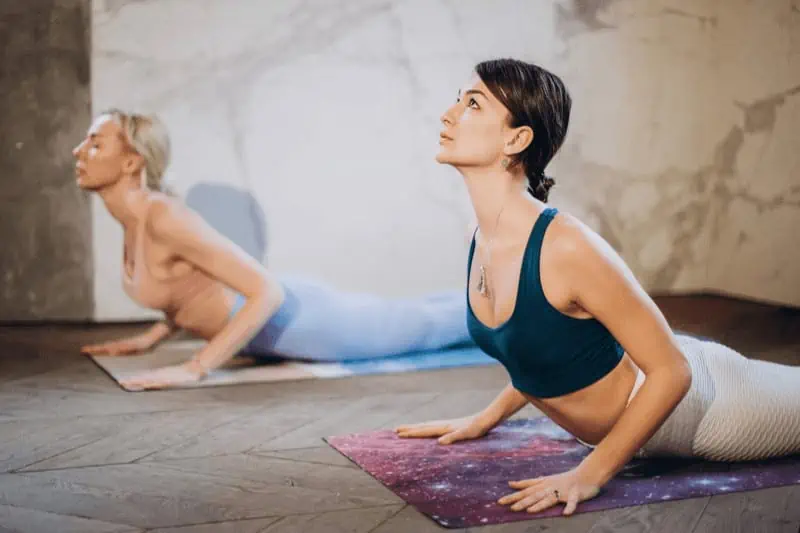
Benefits of Practicing Upward Facing Dog Pose
This asana is a game-changer for the entire body. Here are some of the physical perks of this classic pose.
- Increases Spinal Flexibility: Practicing this asana, especially in a sequence with complementary yoga poses, improves spinal mobility and flexibility.
- Encourages Good Posture: The spinal extension and upper body expansion of Upward Dog counteract the adverse effects of sitting such as a rounded low back and slumped shoulders.
- Opens Chest and Lungs: The chest expansion in this pose allows your lungs more room to expand, so you can take in more air with each inhale. That means more oxygen to your brain and all your body’s cells!
- Strengthens Upper Body: You use considerable upper body strength when you hold this asana and move into and out of it. It’s great for toning your arms and shoulders and can strengthen your wrists.
- Stretches Front Body: Stretching the front body stimulates your abdominal organs and can help improve digestive function.
- Boosts Energy: This asana, especially when used in a sequence, promotes circulation, giving your brain a boost of freshly oxygenated blood to leave you feeling energized and mentally clear.
Urdhva Mukha Anatomy Insights
To help you understand the proper alignment of Upward Facing Dog Pose, let’s take a closer look at the anatomy of the asana. Here’s what’s going on internally:
- Stretches hip flexors: Your hip flexors, located at the front of your pelvis, get a significant stretch in Upward Dog. This is crucial because tight hip flexors can lead to postural issues and lower back pain. Practicing this pose regularly keeps these muscles long and flexible.
- Core Activation: As you move into the pose, your core abdominal muscles are hard at work. As you hold the position, they stabilize your torso and protect your low back, supporting your weight against gravity. A strong core is vital for almost every movement in daily life.
- Spinal Extension: This anatomy-focused pose requires a deliberate extension of the spine. You’re working against gravity to lift your chest toward the sky while keeping your legs active and off the mat. This action strengthens the posterior chain and helps improve posture.
- Gluteal Support: Activating your gluteal muscles is another crucial aspect of Urdhva Mukha Svanasana. When appropriately engaged, these muscles support your pelvis and lower back and reduce strain during this intense backbend.
- Shoulder Engagement: The shoulder joint is highly mobile and thus prone to various injuries. This pose strengthens the shoulder girdle. Maintaining stability in your shoulder joint is vital to prevent injuries, especially as you age.
Integrating Upward Facing Dog into Yoga Sequences
Transitioning smoothly from one pose to another is crucial for flow and safety in yoga classes.
The Classic Vinyasa Sequence
The most common way to use this asana in Vinyasa is to move from Chaturanga Dandasana (Four-Limbed Staff Pose) directly into Upward Facing Dog by rolling over your toes and straightening your arms.
Balanced Mobility Routine
Combining Upward with Downward-Facing Dog creates harmony in practice. Flow between these complementary poses to lengthen, open, and energize the front and back body.
Warm-Up Sequences
Use this asana early in dynamic warm-up yoga sequences to prepare the spine for deeper backbends. Gradual engagement prepares you for more intense poses later on while avoiding injury.
Preparatory and Follow-Up Poses for Balance
Before diving into the Upward Facing Dog, it’s essential to warm up sufficiently. Afterward, follow-up poses can help balance out the intense effects of this powerful position.
Warm-Up Poses
- Cat and Cow: The best way to wake your body up and prepare it for backbends is by flowing with your breath through a few rounds of Cat and Cow stretches.
- Cobra Pose: Starting with the Cobra is always a smart choice. It helps you gradually work up to the deeper backbend in Upward Facing Dog without pushing too fast.
Counterpose With Child’s Pose
The go-to counterpose for most backbends is Child’s Pose. It brings your spine into easy flexion to counteract the extension of Upward Facing Dog. Plus, it gives your arms and shoulders a chance to relax.
Follow-Up With Bridge Pose
Bridge Pose is a fabulous strength builder to use after Upward Facing Dog. Bridge Pose engages the muscles along the back of your body — your posterior chain muscles — to build more power. Plus, you can continue to work on opening the front body with this heart opener.
Need a refresher on any of these yoga poses? We have an extensive library of pose guides here!
Conclusion
Despite its widespread use in the most well-known yoga sequences, Upward Facing Dog Pose proves challenging for beginning students. I hope by understanding the anatomy of this classic pose, you now have a clearer picture of proper alignment.
Upward Facing Dog is trickier than many people realize. Paying close attention to your alignment in this pose is an opportunity to build body awareness and prevent injury as you advance your yoga practice.
Ready to put your new-found alignment knowledge into practice? Visit Yogadownload.com and check out some of their free yoga classes.
Embrace the journey of self-discovery through yoga by starting with this powerful asana. Dive deeper into your practice; let the discipline of yoga elevate your health and consciousness. Begin today — your path to a stronger, more flexible self awaits.
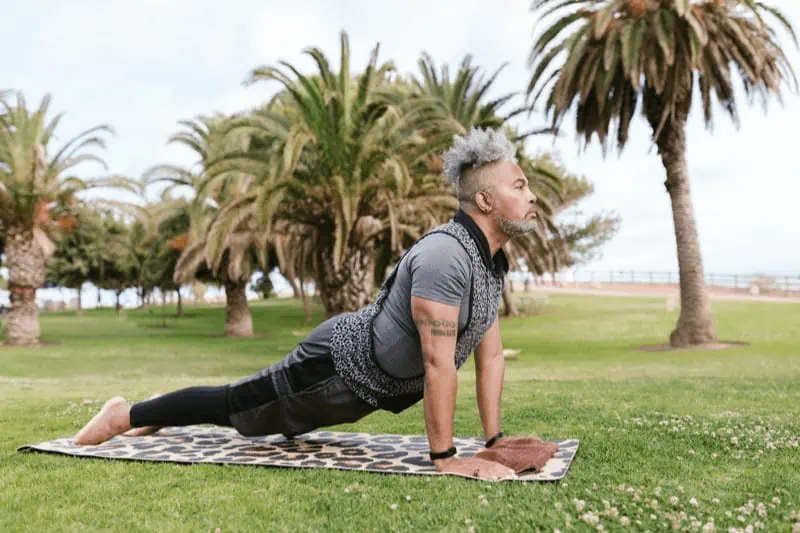
FAQs
What is Upward Facing Dog Pose?
Upward Facing Dog is a prone, back-bending yoga asana in many classic yoga sequences.
What are the benefits of practicing Upward Facing Dog Pose?
This posture helps strengthen the arms, shoulders, and wrists while stretching the chest, lungs, and abdomen. As a spinal extension, it can also boost energy and improve posture.
Is Upward Facing Dog Pose suitable for beginners?
Yes, however, it is crucial to learn the correct form. Beginners or those with limited spinal mobility can substitute this asana with Cobra. Attending a yoga class or seeking guidance from a certified instructor can provide beginners with the support needed to practice safely.
Can this asana help with back pain?
Upward Facing Dog can benefit individuals with mild backaches as it stretches and strengthens the back muscles. However, it’s crucial to perform the posture correctly and with caution. Individuals with prior injuries or chronic pain should consult a medical professional regarding their exercise routine.
What is the difference between Upward Facing Dog and Cobra?
The asanas are both backbends performed in a prone position. In Upward Facing Dog, the arms are straightened completely, lifting the thighs and knees off the floor, which engages the core and legs more actively. In Cobra Pose, the arms are bent, and the thighs and hips remain grounded.
How often should I practice Upward Facing Dog Pose?
Aim to include Upward Facing Dog Pose in your yoga sequences several times a week to feel its benefits and improve your flexibility and strength.


